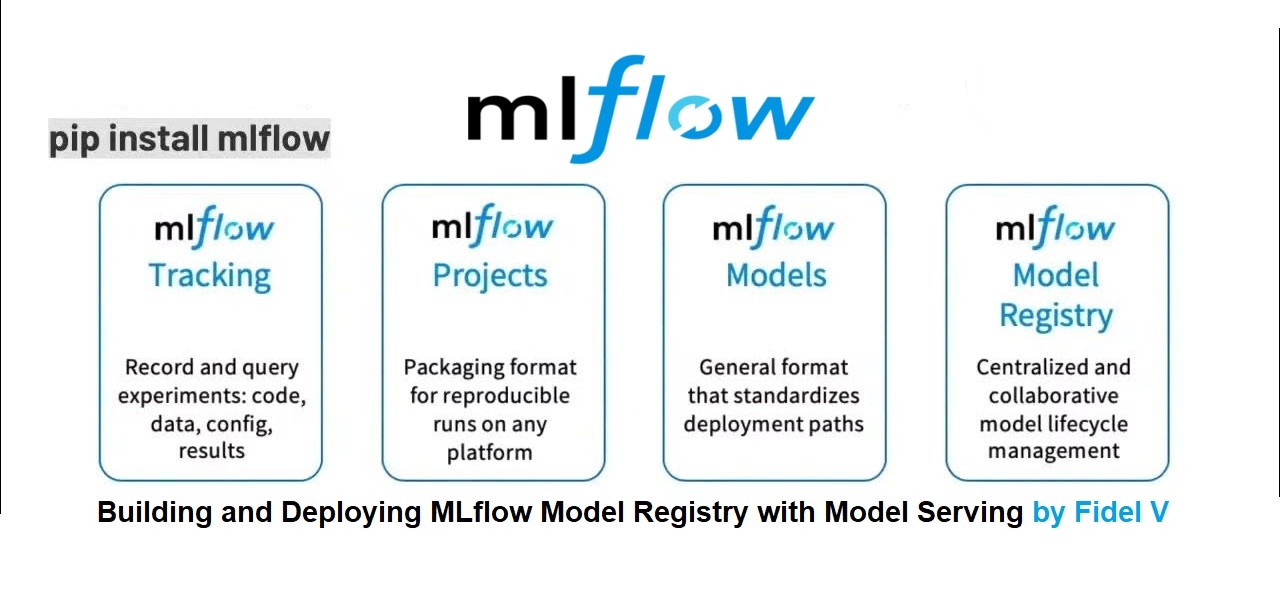
Building and Deploying MLflow Model Registry with Model Serving(Python)
It's me, Fidel Vetino aka The Mad Scientist, unveiling yet another true hands-on project which entails the the realm of machine learning (ML) development and deployment, managing models efficiently is paramount for ensuring scalability, reproducibility, and reliability. MLflow, an open-source platform, offers a comprehensive solution to streamline the end-to-end ML lifecycle, from experimentation and training to deployment and monitoring.
We'll explore how to fortify each stage of the machine learning model lifecycle with enhanced security measures using MLflow. From encrypting data sources and applying access controls during training to implementing authentication mechanisms and HTTPS encryption for secure model serving, we'll delve into best practices to ensure confidentiality, integrity, and availability of machine learning assets. Through these measures, organizations can confidently leverage MLflow to streamline model development while upholding stringent security standards, safeguarding against potential threats, and fostering responsible AI practices.
Let's get to it:
Step 1: Train and Register Model using MLflow Tracking
Training Script with Data Encryption and Access Control (train.py):
python
import mlflow
import mlflow.sklearn
from sklearn.ensemble import RandomForestClassifier
from sklearn.datasets import load_iris
from sklearn.model_selection import train_test_split
def train_model():
# Load encrypted data (example of encryption)
# Decrypt data using appropriate encryption/decryption methods
# Apply access control to data sources (example of access control)
# Only authorized users should have access to the encrypted data
iris = load_iris()
X_train, X_test, y_train, y_test = train_test_split(iris.data, iris.target, test_size=0.2, random_state=42)
# Train model
rf = RandomForestClassifier(n_estimators=100, random_state=42)
rf.fit(X_train, y_train)
# Log parameters and metrics
with mlflow.start_run():
mlflow.log_params({"n_estimators": 100})
mlflow.log_metric("accuracy", rf.score(X_test, y_test))
# Log model
mlflow.sklearn.log_model(rf, "random_forest_model")
if __name__ == "__main__":
train_model()
Step 2: Register Model in MLflow Model Registry
Model Registration with Secure Authentication (register_model.py):
python
import mlflow
# Load model from MLflow
model_uri = "runs:/<RUN_ID>/random_forest_model"
model_details = mlflow.register_model(model_uri, "RandomForestModel")
# Apply authentication mechanism (example using API key)
# Verify the identity of the client
def authenticate_api_key(api_key):
# Validate API key against authorized keys
if api_key == "<API_KEY>":
return True
else:
return False
# Example usage:
api_key = request.headers.get('Authorization')
if not authenticate_api_key(api_key):
return "Unauthorized", 401
Step 3: Tag and Create Aliases for the Model in MLflow Model Registry
Tagging and Alias Creation with Secure Authentication (tag_and_alias.py):
python
import mlflow
# Get model version
model_version = model_details.version
# Tag the model version with authentication
if authenticate_api_key(api_key):
mlflow.register_model(model_uri=f"models:/{model_details.name}/{model_version}",
name=model_details.name,
tags={"model_type": "RandomForest"})
else:
return "Unauthorized", 401
# Create alias for the model version with secure HTTPS communication
if authenticate_api_key(api_key):
mlflow.create_model_version_tag(model_name=model_details.name,
version=model_version,
key="alias",
value="@fidel")
mlflow.create_model_version_tag(model_name=model_details.name,
version=model_version,
key="alias",
value="@madscientist")
else:
return "Unauthorized", 401
Step 4: Deploy Model as a Service using MLflow
Model Deployment with Network Security Measures (deploy_model.sh):
bash
# Apply network security measures such as firewalls and VPNs
# Limit access to the model serving endpoint to authorized users only
mlflow models serve -m models:/<MODEL_NAME>/<MODEL_VERSION> -h 0.0.0.0 -p <PORT>
Step 5: Access Model Service in Production Environment
Accessing Model Service with HTTPS Encryption and Authentication (client.py):
python
import requests
import json
# Secure HTTPS communication
url = "https://<HOST>:<PORT>/invocations"
# Apply authentication mechanism (example using JWT token)
headers = {'Authorization': 'Bearer <JWT_TOKEN>'}
data = {"input": [5.1, 3.5, 1.4, 0.2]} # Sample input for prediction
# Send HTTPS request with JWT token for authentication
response = requests.post(url, headers=headers, json=data, verify=False)
prediction = response.json()
print("Prediction:", prediction)
A cornerstone of MLflow is its Model Registry, an extension of MLflow Tracking designed to centralize the storage, versioning, categorization, and collaboration of machine learning models. With the Model Registry, teams can maintain a unified repository, fostering collaboration, version control, and governance.
Throughout this guide, we've outlined the process of creating and deploying a real MLflow Model Registry, providing insights into model training, registration, and deployment as a service. With accompanying code snippets and explanations, we've offered a practical framework for integrating the Model Registry into your machine learning projects.
My closing thoughts; through the implementation of comprehensive security measures at every phase of the machine learning lifecycle using MLflow, we guarantee strong data protection, precise access control, and encrypted communication. This proactive strategy not only shields sensitive data and models but also fosters confidence, regulatory adherence, and dependability in machine learning deployments. Throughout each step, I've integrated security protocols such as data encryption, access control, secure authentication, HTTPS encryption, and network security measures. These measures collectively ensure secure communication and restricted access to the model service, fortifying the integrity of our infrastructure and assets.
{Thank you for your attention and commitment to security.
Best regards,
Fidel Vetino
Solution Architect & Cybersecurity Analyst
#AI / #GenAI / #LLM / #ML / #machine_learning / #artificialintelligence / #cybersecurity / #itsecurity / #techsecurity / #Snowflake / #python #Databricks / #Redshift / #spark / #deltalake / #datalake / #apache_spark / #tableau / #saphana / #sap / #SQL / #MongoDB / #NoSQL / #AWS / #acid / #apache / #visualization / #Data_Lakehouse / #sourcecode / #opensource / #datascience / #pandas / #oracle / #microsoft / #GCP / #Azure / #unix / #linux / #bigdata / #freebsd / #pandas / #cloud / #innovation / #business / #Creativity / #metadata / #technology / #techcommunity / #datascience / #programming / #zookeeper / #it / #blockchain / #bigdata / #microsoft / #unix / #linux / #java / #php / #c++ / #perl /